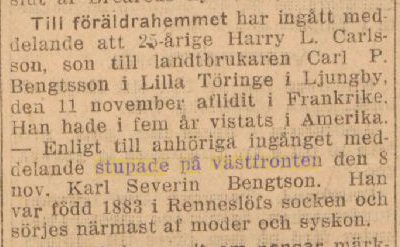Through my constant search for interesting Swedish connections to the Great War, I came across an interesting note about a Swedish born soldier who joined the Canadian Army just a few days after the war broke out. He was discharged in January 25, 1919, and was lucky to have survived. The soldier was John Sigfried Zetterman.
John Sigfried Zetterman was born as Johan Sigfrid Sätterman in Ransäter parish, Munkfors, Värmland, Sweden, on November 13, 1878. He was raised by his parents Ingeborg Persdotter and Eric Olsson.
His surname Sätterman is noted in the Swedish church books, and it may come from his older brother Carl E Zetterman (Karl Engelbrekt Sätterman) who called himself “Sätterman” in the church books before he left for North America in 1895. Two more siblings left for North America already in 1882 and 1891.
Johan left Sweden in November 1901, and arrived in New York in January, 1902. John lived with his brother Carl in Kokomo, Howard County, Indiana, for several years, but when the war broke out he enlisted for the Canadian Army on August 10, 1914, just a few days after Great Britain declared war. He signed his Attestation Papers for CEF on August 22, 1914.


He arrived in France February 12, 1915, and already on April 25, 1915, he received his first wound, GSW in hand and arm, during the fightings in the area of Langemark, Belgium. He was sent to rest in the 12th Stationary Hospital in Rouen, France.
He was wounded a second time during the fightings in the area of Courcelette in France, in September 1916. In June 1918 he was gassed so severely that he was sent to a rest camp in England. He stayed there until the armistice, and later on returned to Canada to receive his final discharge on January 25, 1919.
John had been a soldier of the fourth Overseas battalion in CEF. He was given a land grant by the Canadian government.
He had the honor to serve longer in the World War than any other Howard County soldier.






John died of Tuberculosis in St Joseph’s Hospital, Parry Sound, Ontario, Canada on May 30, 1928.

It is not known to me, on this moment, where he is buried today. So far he may be the Swedish born soldier that I have read about so far, that have served the longest in the Great War. May he rest in peace.







